Do you have a favourite Christmas song? Let us know by voting here and on social media too @randamag
[totalpoll id=”5167″]
Do you have a favourite Christmas song? Let us know by voting here and on social media too @randamag
[totalpoll id=”5167″]
These are the trained volunteers who, for the past seven years, have walked the streets of Woking town centre every Friday and Saturday night, from 10pm till 4am, offering help, or a listening ear, wherever it is needed.
Typically Street Angels look after people who have had too much to drink and are ill, vulnerable or just need help getting home.
They also chat to the homeless and other lonely or needy people on the streets, and generally help make our town centre more pleasant for the hundreds of night-time visitors.
This vital work by Woking Street Angels has been noted by Surrey Police, who reported that in 2014/15 violent crime in the town centre reduced by 64% during the hours that the street angels were active, and that this reduction has further reduced year-on-year.
Woking Street Angels now urgently need more team members and are asking anyone over the age of 18, and particularly those whose friends or families benefit from their help, to consider volunteering. Full training is given, and once trained they commit to just one shift a month. Street angels always walk around in teams, never alone, and may be of any faith or none.

If you would more information about Woking Street Angels please visit www.wokingstreetangels.org.uk or contact the co-ordinator on 07827 914714.
Christmas Eve is here and Clara has just been given a wooden nutcracker in the shape of a handsome Prince. Little does she know she and her brother Fritz are about to be drawn into the adventure of a lifetime.
The Mouse Queen has stolen the magic of the Christmas Tree star and the whole Land of Make Believe itself is in danger. The children, a host of toys and the Nutcracker Prince himself, must battle the rotten royal rodent to save the magic of Christmas and restore the Prince to the throne. But first, Clara and Fritz must learn how to believe…
The Story Pocket Theatre team are back at Farnham Maltings with a colourful and high-energy new version of The Nutcracker. A sparkling new adaptation of Christmas story that has thrilled and delighted children for generations promises seasonal magic and wonder. The colourful, spectacular and fun-filled show has been produced by the award-winning team behind the success of Arabian Nights, A Pocketful of Grimms, Storyteller, Storyteller, Michael Morpurgo’s King Arthur and, most recently, David Baddiel’s ANiMALCOLM.
Will Clara and Fritz learn how to believe, and save Christmas and the Land of Make Believe? Well to find out catch The Nutcracker from Thursday, 20th December, 2.30pm & 4.30pm, Friday 21st & 22nd, 11.30am & 2.30pm at Farnham Maltings, Bridge Square, GU9 7QR. To buy your tickets, £10, call 01252 745444 or visit www.farnhammaltings.com
Peter Anderson
Danielle Giornandi and Laura Goddings wanted to bring something to Godalming that would reinvigorate the high street and give something fellow locals could get excited about.
Coming from backgrounds in humanitarianism, art history, jewellery design, event design and management, and sales they realised they had the right skill set for this kind of venture to be successful.
Danielle says: “One day over coffee, Laura said ‘hey, that old little shed is up for rent, shall we see it?’ ‘Yes!’ I said, though we had no idea what we were looking at or why. The moment we went in, the space just spoke to us and we both spontaneously had the same idea – to have a kind of brick-and-mortar Etsy, permanent contemporary craft fair promoting independent artists and creatives. Throwing caution to the wind, we put in a bid…and we got it!”
The pair’s idea has grown into an amazing venture with more than 40 artists, almost all local, renting a little space, specifically sized and designed for them and their type of products.
“We’re excited to provide Surrey residents with high-quality, unique, handmade goods created by independent artisans and producers,” adds Laura. “In an age when the high streets are dominated by chains and mass-produced products, we pride ourselves on representing and working for both the artists and the consumers. With the rise of online shopping, our high streets have taken a huge hit. We want to re-establish the relationship between consumer and producer, as well as reigniting that tactile and sensory experience a shopper has when they find a product in a shop – something that cannot be reproduced online.”
More than 150 people attended the opening party in October. “Everyone that’s come through the doors has been so surprised and pleased that something exciting like this has come to Godalming. We look forward to a successful Christmas shopping period, highlighted by events such as the Godalming Christmas Lights Festival and Late Night Shopping Evenings with Prosecco. We are determined to make Yard Market more than just a shop, but an exciting and vibrant community creative space.”

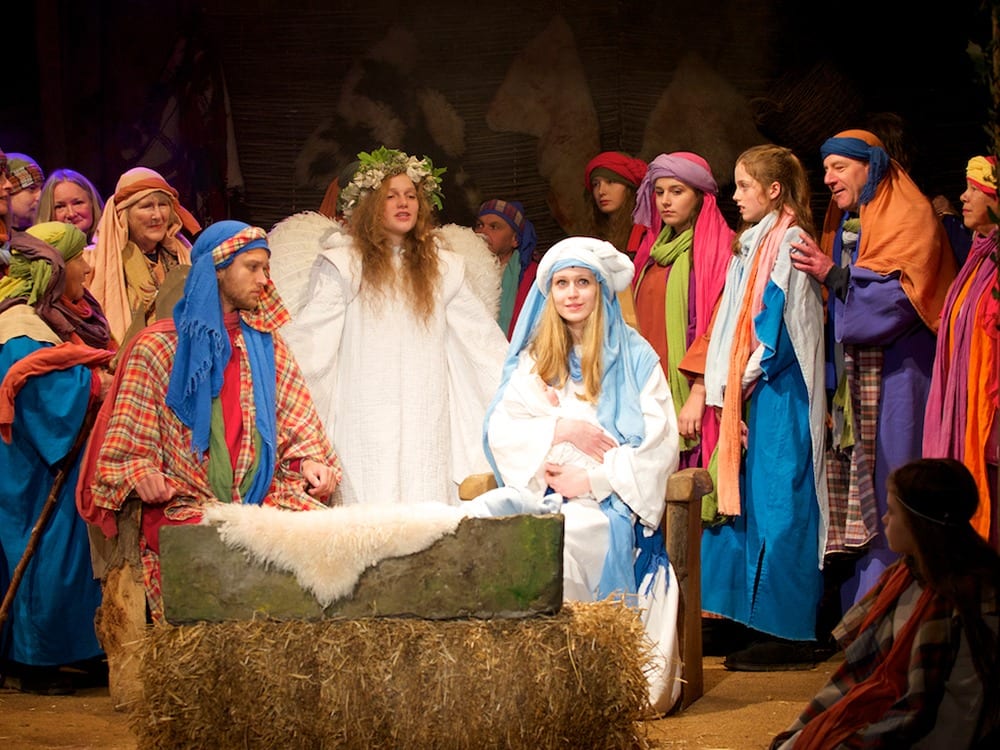
The Christmas story began just over 2,000 years ago in a barn in Palestine, and once again this year visitors will flock to a barn in Surrey to see that magnificent story unfold once again before their eyes. The Nativity has become a much-anticipated fixture of the Christmas season, performed by the Wintershall Players.
A volunteer cast of 50 in biblical costumes, assisted by a full complement of sheep, donkeys, horses and a sheepdog, will take the audience on foot from the chill open air into the atmospheric, candle-lit barn, as the story of how Jesus changed the world unfolds with songs and music and joyful carolling.
The Wintershall Nativity once again brings the story to life in natural beauty of the rolling Surrey hills, as it has since the late 1980s. The extraordinary story of these productions has its modest beginnings in Medjugorje, Bosnia, visited by Ann Hutley and her daughter Charlotte in the mid-1980s. The visit changed their lives. Peter joined Ann on a visit in 1989.
He wrote and produced the original production in the barn in 1989, and since then the audience has grown from a small group of friends, to last year when over six thousand people saw the performances. The Wintershall Nativity is now produced by his daughter, Charlotte de Klee who had travelled with her mother to see that show in Bosnia.
Peter Hutley whose concept this was, has been awarded both an OBE and an MBE for his work promoting Christian understanding, and it is not just the nativity play for the Wintershall cast also come together to perform the Passion of Christ at Easter, at Wintershall, Guildford and Trafalgar Square, but also an epic Life of Christ at Wintershall during the summer. In 2011, her Majesty Queen Elizabeth II awarded the Wintershall cast, artistic director and support team the Queen’s Award for Voluntary Service.
This is a magical show to share with friends and family and a rare opportunity to experience the true meaning of Christmas. The Wintershall Nativity Play will be performed from the 12th to the 16th of December both inside and outside of Holly Barn at Wintershall in Bramley near Guildford. There is free parking and visitors are encouraged to wrap up warmly and mince pies and hot drinks will be available before and after the show.

For further information, please visit www.wintershall.org.uk
Kate Hicks Beach, Natanya Phillips and Jackie Colburn will present what has become an annual Christmas concert of music and words featuring the Coln Choir, solo singers and seasonal readings read by actors.
This year they are once again supporting the amazing charity Hands Up Foundation and will be “Singing for Syrians”.
The charity seeks to aid those people caught up in the Syrian crisis, left without homes, education, access to hospitals and in many cases hope. They work very closely with Syrians in Syria and this year have funded the salaries of 22 medical staff in Aleppo £150,000; supported the Syrian Project for Prosthetic Limbs with a contribution of £80,000 – (there are an estimated 50,000 amputees in Syria, the average cost for a prosthetic limb above the knee is £500) and in partnership with Syria Relief, are funding medical training in Idleb City £105,000 with a view to lessening the imbalance in demand and supply for medical care. This imbalance is due to the fact that most specialised personnel have fled the country over the past 5 years and a large number of medical students have not been able to complete their studies and receive a degree.

• So enjoy a glass of wine and canapés, from 6.30pm St Mary’s Church, Bibury. Tickets £12 from the Bibury Trout Farm, Coln Village Stores or email [email protected]
Q. What inspired you to go into acting? “I have always been interested in acting and drama, including making my own animated short films when I was younger with my dad’s Super 8 camera. I was born in – and have always lived in – the Reading area and went to drama school in Guildford. A chance meeting with Philip Scofield led me to asking him how I might get into BBC children’s television. He said ‘make a showreel’, and so I did! Having experience with the Super 8 was a great help. Now I have my own production company and am still loving my children’s television work.”
Q. Who were your inspirations? “One of the people I always wanted to appear with was David Suchet, whose career was also launched in Berkshire [at The Watermill in Newbury]. But one of my real loves – and obviously great for pantomime – is slapstick. I adore watching Laurel & Hardy and their looks directly to camera. I was blessed to have been taught slapstick by Jack Tripp, who is sadly no longer with us. He was considered one of, if not the best pantomime dame in this country.”
Q. How do you think children see your character within this year’s pantomime, at Reading’s Hexagon? “Although I am known and billed as ‘CBBC’s Mr Tumble’, I probably take on more than 20 roles across the programmes I make. But it is very important for the children to understand within the pantomime [Aladdin] who my character is. So, every performance we always have fun with the children about who I am as a character in the pantomime, and get them on-side to help me through the rest of the show.”
Q. Do you enjoy doing panto? “I always enjoy doing pantomimes, in the same way I enjoyed going to the Hexagon as a child in the 1980s to watch them. Aside from, as I said, slapstick being one of my favourite kinds of theatre, it is a marvellous way to get people – especially families – to go to the theatre. Pantomime is one of those things that can be enjoyed by the whole family, parents and children. Then if we can get them coming to pantomimes as they grow older they may wish to try other types of show.”
l Justin is patron of local charity Make A Wish foundation: www.make-a-wish.org.uk

Click here for more interviews.
(makes 24)
These are great to make ahead and present in a glass jar or tin when you are serving coffee or after-dinner liqueurs. Dip these in Vin Santo to transport yourself to heaven. Give me these over mince pies any day!
Preheat your oven to 170°C. Add 220g of plain flour, 1½ tsp of baking powder, generous pinch of salt, 60g of ground almonds, 120g of whole almonds and 150g of golden caster sugar to a large bowl and mix together. Lightly beat two eggs and add to the mixture with 1tsp of almond extract and bring together with a wooden spoon. Use your hand to bring the dough together into a ball (it may be a little sticky) then lightly flour a work surface, divide the mixture into two and roll it into two long sausage shapes, about 20cm long each. Lay on a baking sheet lined with parchment and cook for 30 minutes. Remove from oven and slice into 1cm thick pieces using a serrated knife then lay flat back on to the baking sheet and cook in a cooler oven at 150°C for another 20-30 minutes or until crisp and golden.
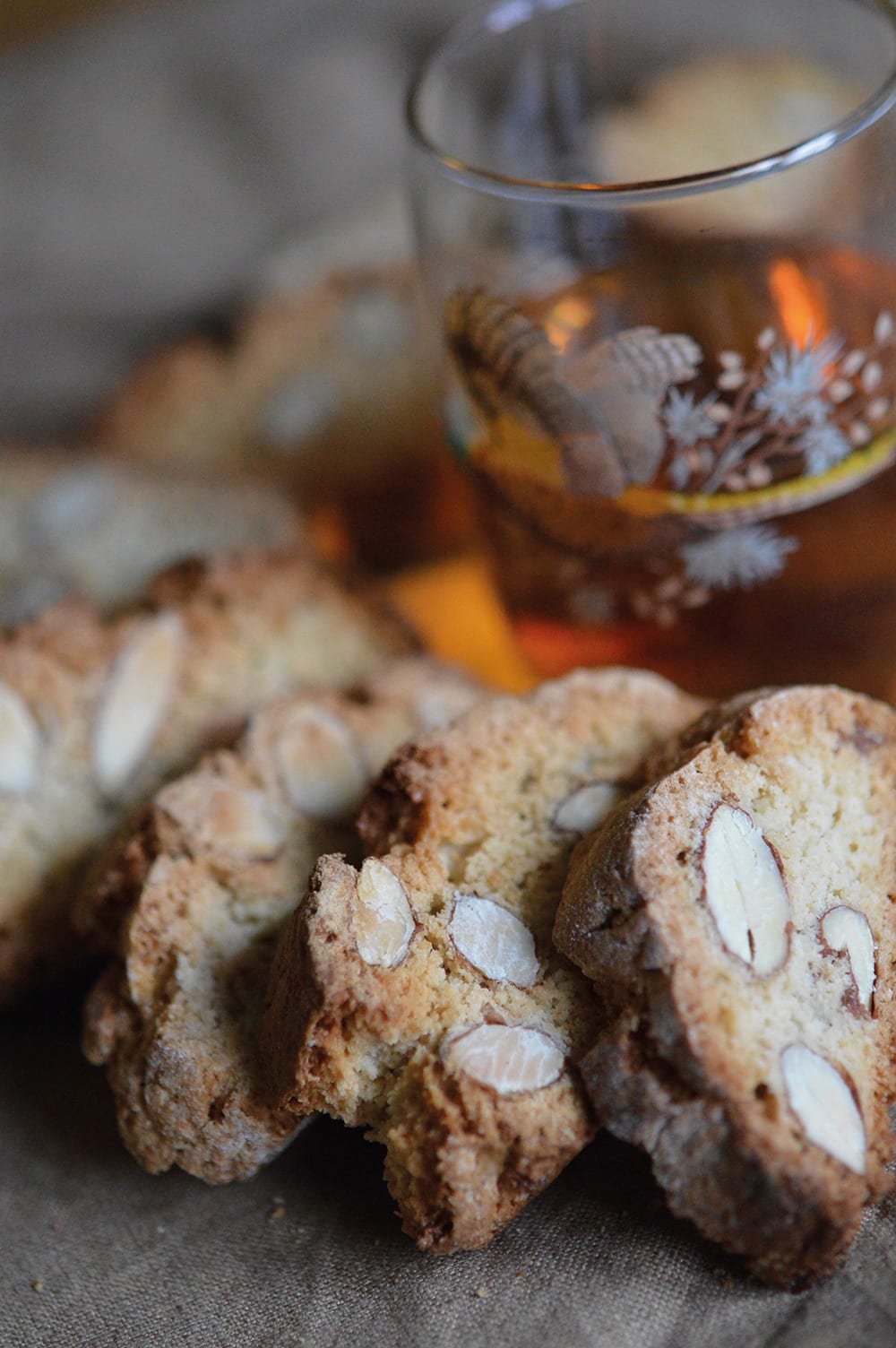
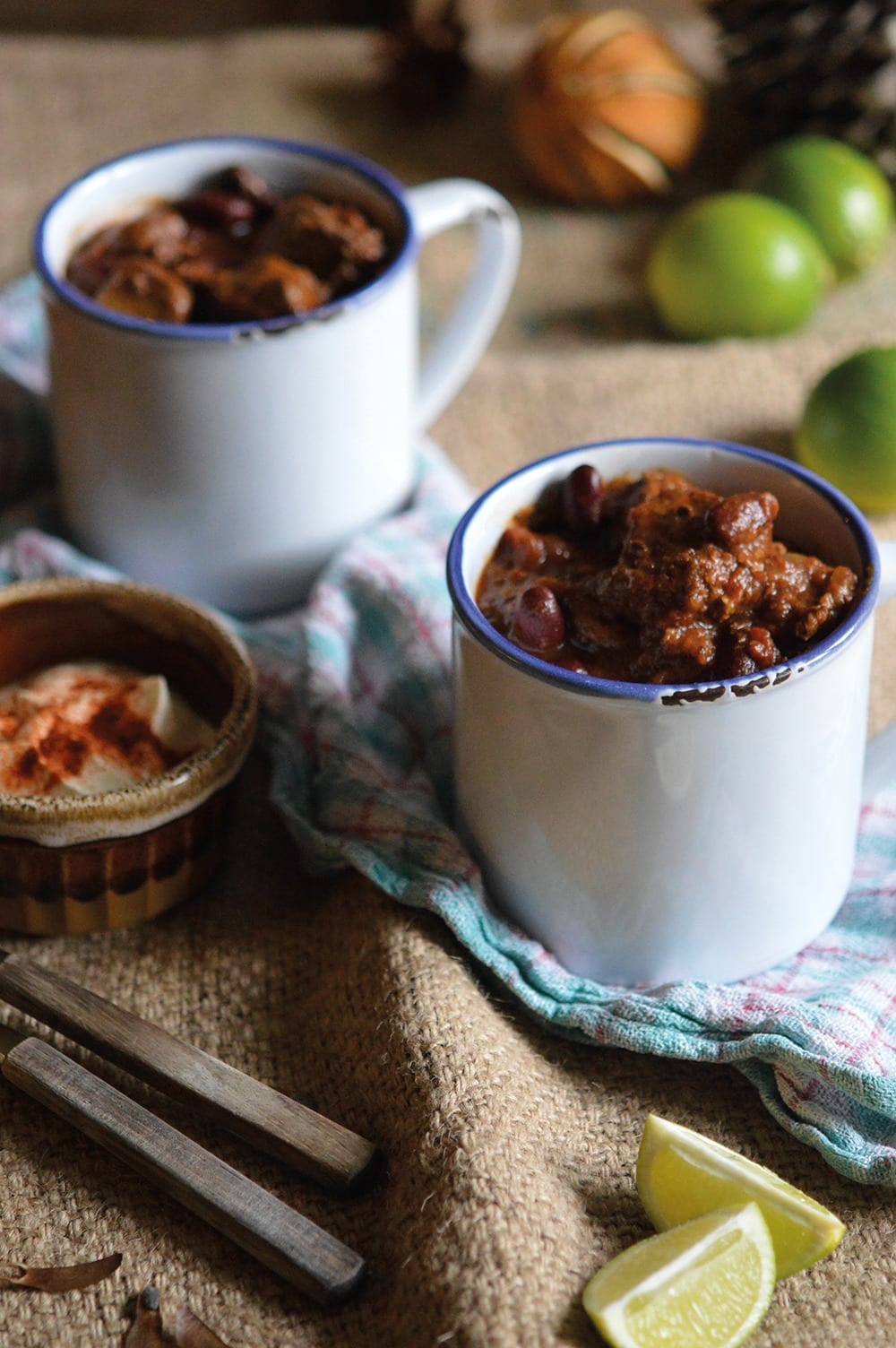
(serves 6-8)
This is the kind of one-pot dinner that gives you a break after all the fiddly, feasting food. Really hearty and another crowd-pleaser. Serve with sour cream with a dusting of paprika, grated cheese, nachos and rice or winter slaw.
Heat your oven to 170°C. Chop 1kg of beef brisket into 2.5cm chunks then brown in a hot pan with 2tbsp of vegetable oil in batches. Transfer the beef to a casserole pan then finely chop two red onions and sauté until softened and starting to turn golden. Add five minced garlic cloves, cooking for a few minutes then add 2tsp each of ground cumin, smoked paprika, dried oregano and ½tsp of ground cloves. Add more oil if you need and cook out the spices then add 2-3tbsp of chilli paste (chipotle or ancho work well) and transfer everything to the casserole with the beef. Add two tins of plum tomatoes and 500ml beef stock and bring to a boil then put the lid on and transfer to the oven for two hours. Drain and rinse two tins of kidney beans and add to your casserole, cooking for a further hour without the lid until the beef is tender. Check seasoning and serve.
(serves 6-8)
Something fresh and tasty to go with leftover turkey or ham. This makes a large bowl and looks great piled high in the centre of the table for people to help themselves. Add some pomegranate seeds for a little sparkle.
In a large bowl mix together 4tbsp of buttermilk, 1tbsp of Dijon mustard, 1tsp of celery salt and the juice and rind of one lemon. Add in two grated carrots, ¼ red and ¼ white cabbage, finely shredded, five finely sliced radishes, five sliced spring onions and a large handful of roughly chopped parsley. Mix together, adjust seasoning to taste and pile high into a serving bowl.
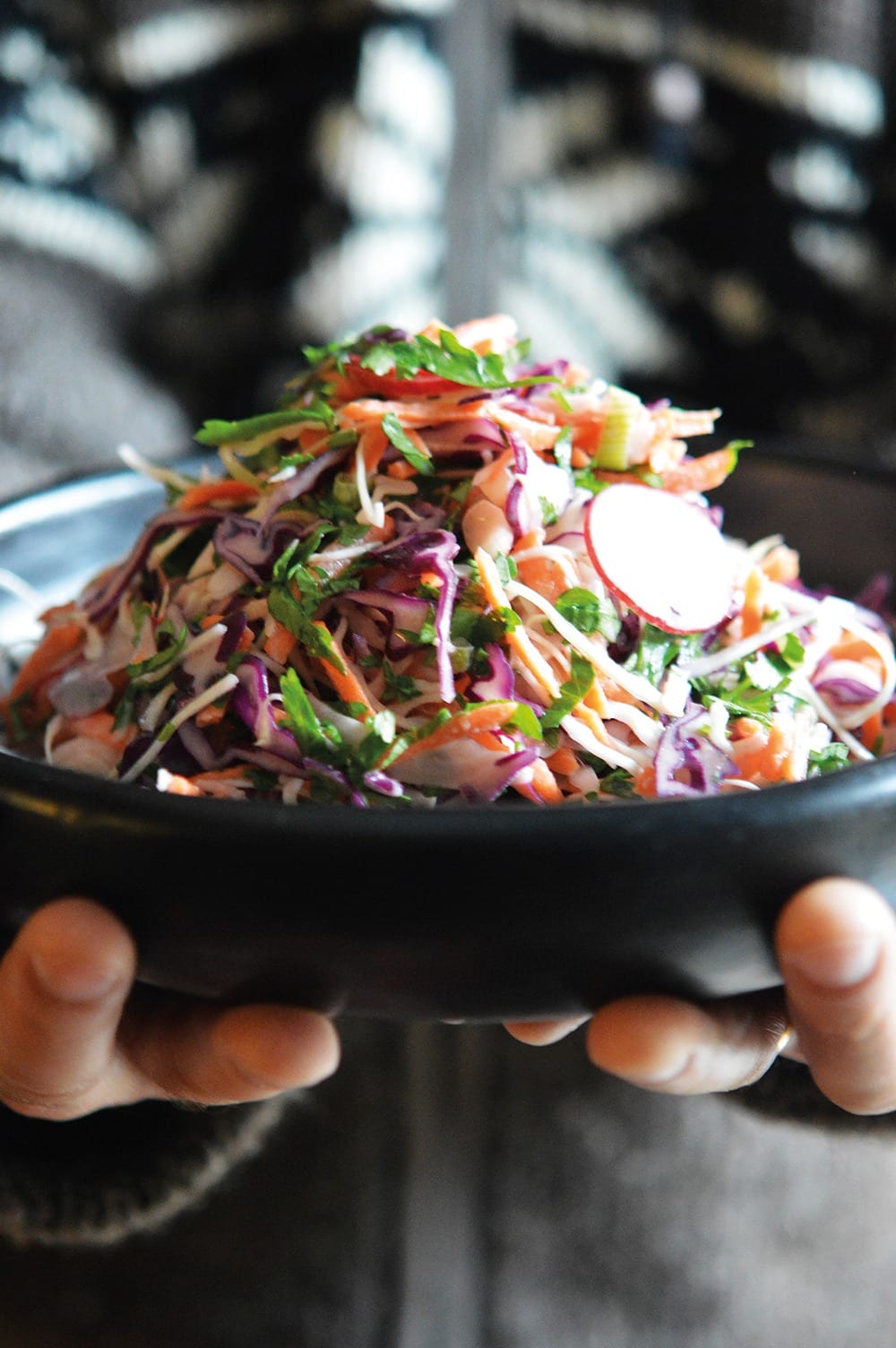
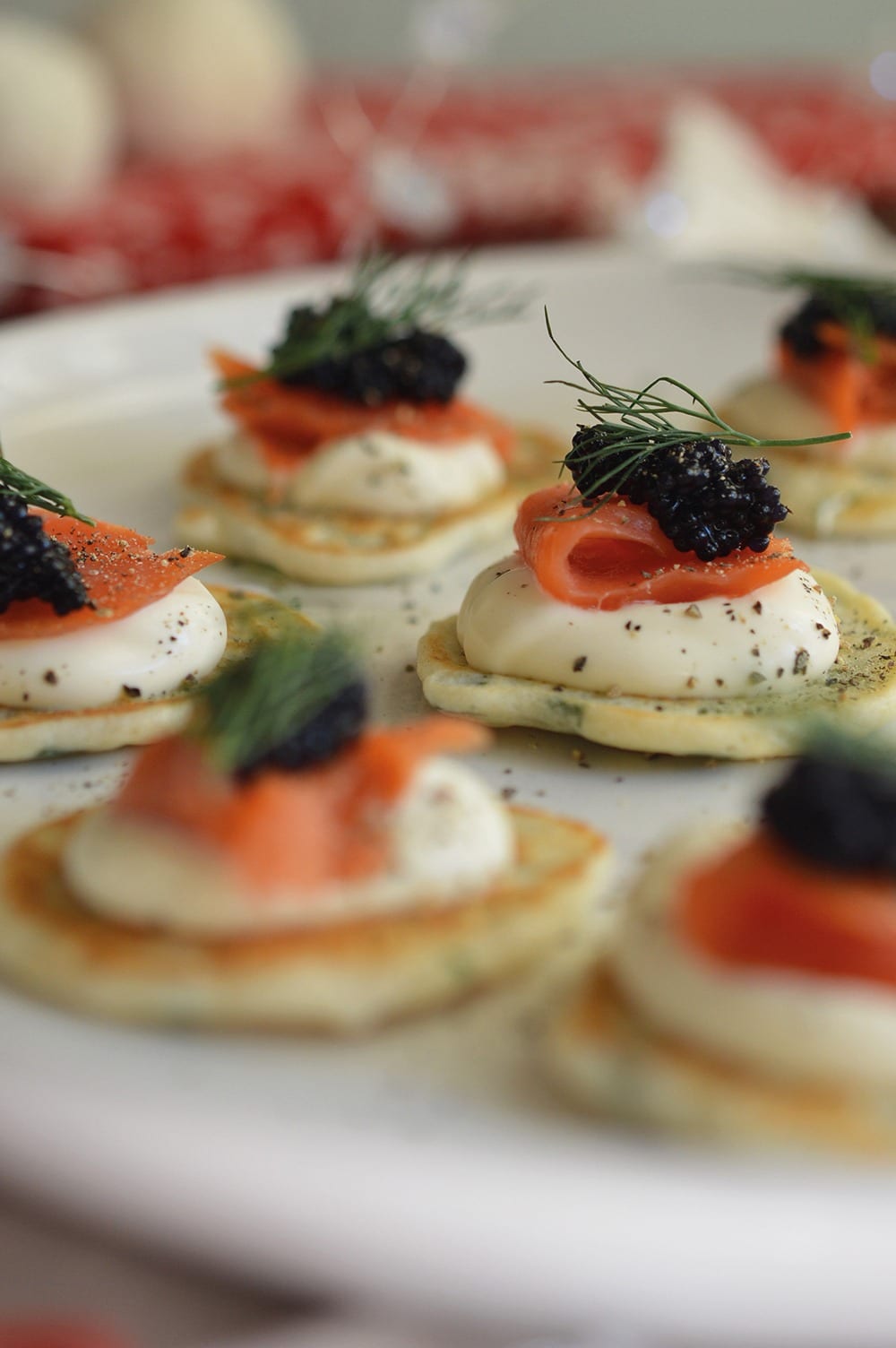
This is always a great crowd-pleaser. I like to serve these on Christmas morning between breakfast and lunch, as we are all opening presents with some bubbles. It is really worth making these yourself as they are far more tasty than shop-bought, just warm in the oven before serving.
In a large bowl weigh out 100g of plain flour and add a generous pinch of salt. Separate an egg, adding the white to a clean mixing bowl and the yolk to the flour. Measure out 150ml whole milk and add half to the flour. Use an electric whisk to whisk the egg white until it begins to stiffen and leave to one side whilst you then whisk the flour mix until smooth. Gradually add the rest of the milk while continually whisking then 25g of melted butter and a handful of chopped chives. Fold through the egg white. Warm a pan and brush with a little butter until it begins to foam then add small spoonfuls of your batter. Cook on a low heat until the bottoms begin to brown then flip and repeat. Serve warm with a dollop of crème fraiche, smoked salmon, caviar and dill.
Q: How did you get into circus and clowning?
A: “I grew up in Aberdeen and had always had an interest in youth theatre. Career-wise I had wanted to be an animator, but then realised that perhaps what I wanted more was to be the character I was animating. I did a lot of research, writing around as this was in the days before computers and the internet and found a clown school in Bristol. I was saving up hard to go there and worked as a Butlins Redcoat which gave me lots of opportunities to try things, but sadly before I got the all the money.
There is a quote from Joseph Grimaldi the best way to learn how to be a clown, is to be one. So, I then wrote to a lot of circuses and got a job with Zippo’s Circus as a publicity clown basically doing the occasional children’s show and standing on street corners handing out leaflets. Then one day one of the main clowns got stuck in traffic and I had to step in they liked my work and I never looked back. I met Nell Gifford when she was a groom in another circus and when she started her own circus I asked her if I could have a job.”
Q: What was your first panto role?
A. “I have done panto alongside clowning nearly all my life. When I was younger, panto casts were bigger, and I played one of two broker’s men. I think I was down in Truro doing pantomime when I met the general manager from the Everyman Theatre [in Cheltenham] and he liked what I did, but it was a number of years before I made it on stage for the pantomime and in between times did a couple of years at the Wyvern Theatre in Swindon in 2000-01 and 2003-04.”
Q: Do you find your slapstick skills honed from clowning help?
A. “Undoubtedly, though I have always been a fan of both Laurel and Hardy and Norman Wisdom.
Q: Do you enjoy the interaction with children, is it similar?
A: “Oh yes, I think in both cases the children are almost like an extra member of the cast and it is great to get that level of engagement.”
Q: What memories of Christmas do you have growing up in Cirencester?
A: “My best memories are sledging in the amphitheatre, loads of people who don’t know each other drawn together for a single enjoyable experience.”

Aladdin, written and directed by legendary Blue Peter presenter and actor Peter Duncan, is on at Everyman Theatre from Friday, 30th November until Sunday, 13th January.
Rampant consumerism hits its peak during December. My ten-year-old is currently obsessed with the LOL dolls which are all about plastic packaging and (with ever more and more to collect, natch) to exploit that acquisitive streak all children have. I’ll indulge her with one, hoping the fad passes the way of Minecraft paraphernalia. Also all the rage are PlayFoam Pals. What about some family board games? Monopoly (created in 1935) has long engaged families in capitalist battles and the new Cheaters Edition (RRP £23.99) takes it to the next level!
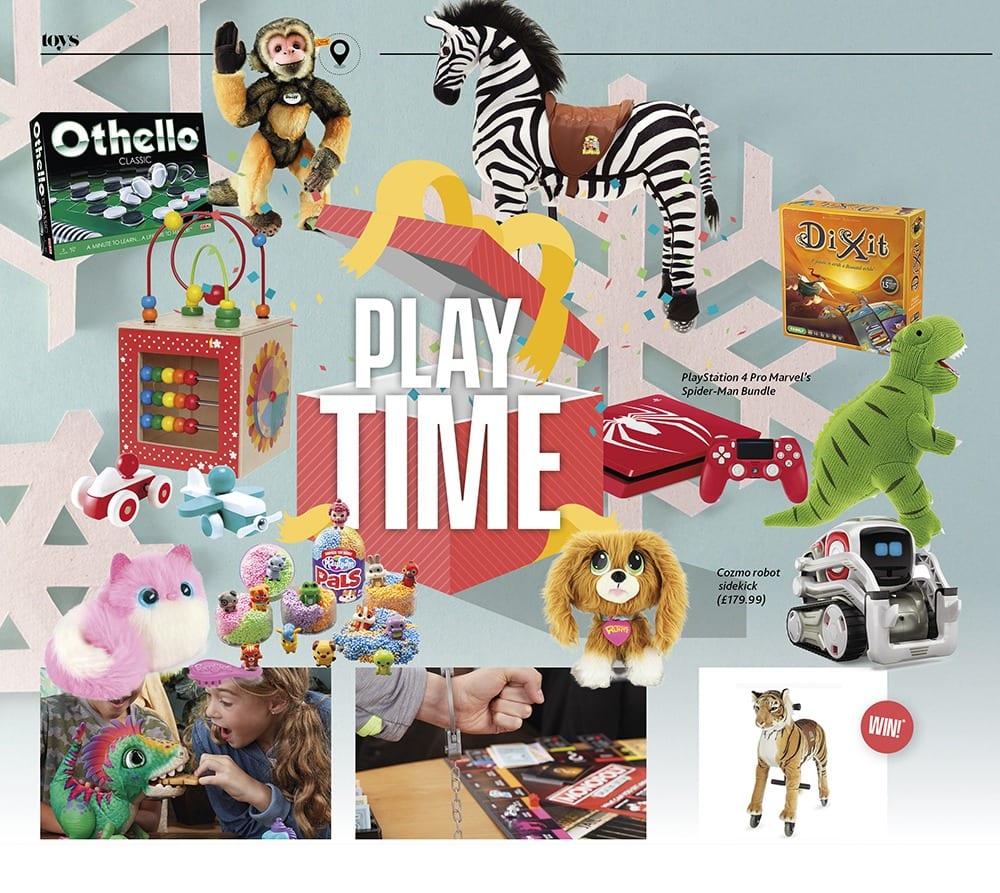
Traditionalists might prefer the new versions of old classics Rummikub , Dixit (RRP £29.99) and Othello (RRP £23.99). Of course we’d all rather our children and grandchildren play with sturdy (not to mention tasteful) wooden toys. The toys by Cornish brand Hape are beauties, such as the Discovery Box (£32.49) and Roadster and Sky Flyer (£8.99) for age one year and up. For real longevity Steiff has been hand-making teddy bears since 1847 and its toys and kids’ clothing is of collectible quality, including Mungo the magnetic monkey (£85). Gifts For A Girl offers top-quality presents such as this Ride-On Zebra (from £219) while supporting charities who care for abandoned and trafficked children, mainly girls, in Cambodia. For more ethical goodies (in a stocking-filler price range) check out the creative range from Clockwork Soldier Shop and, for dinosaur-mad children, do also check out the lovely range from the Natural History Museum shop, including the cuddle T Rex and Cluedo paleontology board game! Remember mood rings from the ’90s? Pomsies (£17.99) are feline plush toys whose eyes change colour according to whether they’re happy, sleepy or hungry, while Rescue Runts (£17.99) encourage their new owners to groom their new puppies clean before their fur becomes messy again and the dirt reappears on their paws… The whole concept reminds me a little of that scene in Withnail & I but at least we have moved on somewhat… Enjoy your Christmas!